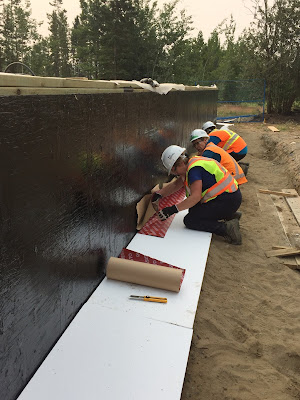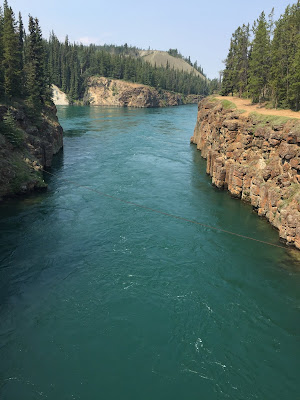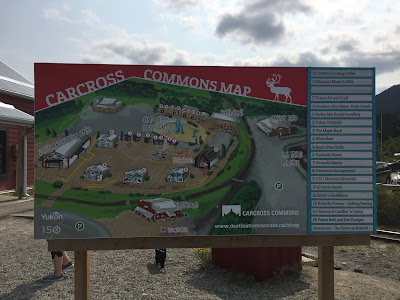Note: I am late in writing this post as the trip occurred several months ago (July 2019).
A bit about "North of 60"
This term is used as a mapping reference for the 60th parallel, which is a circle of latitude 60 degrees north of the Earth's equator. While it crosses, Europe, Asia, the Pacific Ocean, North America and the Atlantic Ocean, the most common use of the term in Canada refers to the map boundary separating the three northern territories (Yukon, Northwest Territories and Nunavut) from the four western provinces (British Columbia, Alberta, Saskatchewan and Manitoba).
During the first half of my professional career I had opportunities to travel "North of 60" when working for the CBC. The first of those trips was to Whitehorse, Yukon, which is where my love affair with Canada's North started.
Why go to Whitehorse again?
On our orientation day, we drove to the build site to get an idea of what to expect the following morning. Everyone was excited to get started and on the first morning, our initial activities included introductions with a few local Habitat people, a safety briefing, assignment of tasks and a land acknowledgement as a show of respect for the First Nations traditional territory in the area where we were working. The photo immediately below shows the view from where the land acknowledgement was done.
I had a great team who came to the build site every day ready to work hard while also enjoying the experience and working well together. As a team leader, it is always appreciated to have a group of people who get along well and bring a positive attitude. These people know and understand what is involved with being a Habitat volunteer and are committed to each other as well as to giving a family a "hand up" to improve their housing situation. In the photo below the team is accompanied by the two local Habitat construction supervisors.
Whitehorse
On the Klondike Highway before arriving in Carcross, we stopped to enjoy the view and take photos of beautiful Emerald Lake.
First thing today, one of the member of the team headed off on another adventure and two others left us in Carcross to travel to Skagway before eventually driving to Calgary. For our final dinner, our group has shrunk to nine, but we had a wonderful evening of conversation, food and fine beverages. Seven of us headed homethe following day after what was a great nine 9 days. The Yukon definitely is “Larger Than Life.” To experience just a bit of that and also give “a hand up” through the Habitat project falls into the category of fantastic.
A bit about "North of 60"
This term is used as a mapping reference for the 60th parallel, which is a circle of latitude 60 degrees north of the Earth's equator. While it crosses, Europe, Asia, the Pacific Ocean, North America and the Atlantic Ocean, the most common use of the term in Canada refers to the map boundary separating the three northern territories (Yukon, Northwest Territories and Nunavut) from the four western provinces (British Columbia, Alberta, Saskatchewan and Manitoba).
During the first half of my professional career I had opportunities to travel "North of 60" when working for the CBC. The first of those trips was to Whitehorse, Yukon, which is where my love affair with Canada's North started.
Why go to Whitehorse again?
For most people who have visited Whitehorse, it is easy to understand why they would want to return. In addition to the natural beauty, warm and welcoming locals, and the Yukon's unique history, it is very satisfying opportunity to provide a "hand up" to a local family by helping on a Habitat for Humanity project. As was the case five years earlier, recruiting a group of people for my team was quick and easy compared to many locations. For most people on my three Habitat trips in the North, there is a strong attraction to seeing a part of the country they have not seen previously. There's no better place to start than Whitehorse!
While our main focus was on five days of construction work, we had a day to settle in/get oriented to the city and surrounding area, and three days for cultural and tourist activities after the construction work was finished. I arrived in Whitehorse a day earlier than most other folks to have some time to relax and do a bit of personal exploring before my team leader responsibilities kicked in.
The Habitat project
Habitat Yukon has undertaken a number of house building projects over the years and we worked on the early construction stage of a four-unit townhouse row located in a residential area called Whistle Bend. This fairly new development started about five earlier and Habitat had previously constructed houses there. On our orientation day, we drove to the build site to get an idea of what to expect the following morning. Everyone was excited to get started and on the first morning, our initial activities included introductions with a few local Habitat people, a safety briefing, assignment of tasks and a land acknowledgement as a show of respect for the First Nations traditional territory in the area where we were working. The photo immediately below shows the view from where the land acknowledgement was done.
The overall project plan for the site is to construct a four-unit townhouse row with three units being new homes for Habitat families and the fourth unit being constructed to be sold at market price with any monetary gain above construction costs being used to support a future project.
The foundation of the townhouse row was in place when we arrived, so our efforts focused on the next stage that included: preparing the foundation/crawl space level for the installation of the main floor of all four houses so subsequent work could move to the main floor, second floor and roofing/trusses. Some task were messy as we work with tar to coat all of exterior foundation walls including seams and cracks - a critical stage to ensure the integrity of the structure for the severe northern climate. In addition, we installed insulation batts on the crawl space walls between units, wrapper the exterior foundation with rigid Styrofoam insulation, and carried our a myriad of other tasks (shovelling and moving a significant amount of sand/gravel around the foundation. At conclusion of our five days, the foundation was completely sealed for protection from water/moisture, the main floor on top of the foundation wall trusses almost entirely in place, and many other 'odds and ends."
I had a great team who came to the build site every day ready to work hard while also enjoying the experience and working well together. As a team leader, it is always appreciated to have a group of people who get along well and bring a positive attitude. These people know and understand what is involved with being a Habitat volunteer and are committed to each other as well as to giving a family a "hand up" to improve their housing situation. In the photo below the team is accompanied by the two local Habitat construction supervisors.
The wonderful weather (sunny and warm in the mid-20s C provided excellent conditions for working outside and for walking around Whitehorse in the evenings when the sunset is quite late at that time of year. The only negative aspect was smoky air moving into the area from forest fires in Alaska.
It is a wonderful city to spend some time - downtown is along the Yukon River with mountains as a backdrop. Even with the smoky air we experienced, Whitehorse is one of Canada's beautiful places.
For those interested, the city has many shops and galleries to browse or for purchasing of local art, crafts and a wide array of souvenirs. For me, one of the "must stops" on all my trips to Whitehorse is Mac's Fireweed Books with the best selection of books about the North that I have seen.
Whitehorse Main Street
McBride Museum
For those interested, the city has many shops and galleries to browse or for purchasing of local art, crafts and a wide array of souvenirs. For me, one of the "must stops" on all my trips to Whitehorse is Mac's Fireweed Books with the best selection of books about the North that I have seen.
There are many fine restaurants and all taste preferences can easily be satisfied in the Yukon capital. Here are just a few - Antoinette's (my favourite), Sanchez Cantina, and Klondike Rib and Salmon.
The McBride Museum is a great place to learn about Yukon history and the many characters that are legendary. The Transportation Museum adjacent to the airport is much better than I expected and it tells about the important role of different forms of transportation played in the history and development of the territory. Just a few minutes away from downtown Whitehorse, a visit to Miles Canyon is well worth it. This is where the Yukon River narrows as it drops to flow through a hydro dam and on to the downtown area. We walked across a foot bridge at Miles Canyon that provides close views of the river. (Three photos below are of Miles Canyon.)
Exploring a bit of the Southern Yukon
Day 1:
On the morning after our last build day, we drove west from Whitehorse on the Alaska Highway for about 45 minutes and turned on to a gravel road to Kusawa Lake Park. Most of us went for a bit of a hike on one of the close mountains and were treated with spectacular views. It wasn't a long hike, however, as some of our group were not interested in the hike and I didn't want those people waiting a long time for the rest of us.
Next we drove further west to Haines Junction for a mandatory stop at the bakery-café to refuel before visiting the Da Ku Cultural Centre where the Southern Tutchone and Tlingit cultures and languages are honoured. While this was a useful cultural experience, I would referred that we have more time there and for someone from the centre to speak to us about First Nations history in the area.
Day 2:
The following day, we drove north on the Klondike Highway a bit more than two hours past the town of Carmacks to Five Finger Rapids, which was one of the hazardous obstacles in the Yukon River on the gold rush route to the Klondike and Dawson City. Sternwheelers navigated through the narrowest channel of the rapids as they made their way along the river. Some people hiked from the parking lot to the rapids, but I stayed behind with the folks who were not interested in the hike (always difficult for me to turn down a hike).
On the return drive, we stopped at the historic Braeburn Lodge for a break that included sharing among the group a few of the renowned plate-size cinnamon buns. The lodge is one of the official checkpoints on the 1000-mile sled dog race The Yukon Quest. The lodge's history includes being a hangout for a motorcycle gang in the southern Yukon!
Day 3:
On the last day in the Yukon (on this trip), we drove south of Whitehorse for about an hour to the town of Carcross. Formerly called Caribou Crossing, the town was an important place on the gold rush journey from Skagway, Alaska to the Klondike in Dawson City and area. Carcross is generally considered as the “hometown” of the Tagish and Tlinglit First Nation. The town of a bit more 300 people is where many talented Yukon artists display and sell their creations in a variety of shops on the Commons. I have visited Carcross a few times in the past and definitely would like to return. On the morning after our last build day, we drove west from Whitehorse on the Alaska Highway for about 45 minutes and turned on to a gravel road to Kusawa Lake Park. Most of us went for a bit of a hike on one of the close mountains and were treated with spectacular views. It wasn't a long hike, however, as some of our group were not interested in the hike and I didn't want those people waiting a long time for the rest of us.
Day 2:
The following day, we drove north on the Klondike Highway a bit more than two hours past the town of Carmacks to Five Finger Rapids, which was one of the hazardous obstacles in the Yukon River on the gold rush route to the Klondike and Dawson City. Sternwheelers navigated through the narrowest channel of the rapids as they made their way along the river. Some people hiked from the parking lot to the rapids, but I stayed behind with the folks who were not interested in the hike (always difficult for me to turn down a hike).
A bit of Yukon humour.































